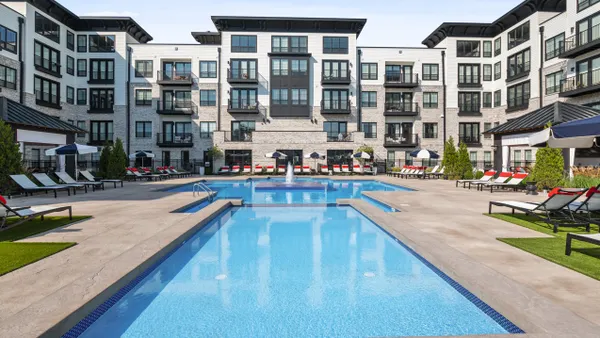Dive Brief:
- After vacancies bottomed out to 4.1% in October 2021, they began creeping back up, according to the newly introduced Apartment List Vacancy Index.
- The vacancy index ticked up for seven straight months after October, hitting 5% in May. Still, the number of empty apartments nationally remains historically low and won’t surpass 6% until 2023 if things continue on the current trajectory, according to Apartment List.
- As vacancies ease, rent growth is decelerating in 2022 after jumping 17.3% in 2021. However, Apartment List notes that “prices are still going up today faster than they did pre-pandemic.”
Dive Insight:
Before the coronavirus pandemic, the vacancy rate was largely stable and demonstrated what Apartment List terms a “healthy” degree of turnover. From January 2017 to February 2020, it never dipped below 6.3% or rose above 7%.
When the pandemic hit, people around the country moved out of apartments and vacancies jumped from 6.6% to 7.3% from February to July 2020. But in the second half of the year, the vacancy rate declined, falling to 6.8% by year-end. By October 2021, it had plummeted to 4.1%.
Apartment List attributed falling vacancies to people who had been living with family or roommates in the beginning of the pandemic moving out to live on their own. As that was happening, renters with expiring leases stayed put and construction delays thwarted much-needed new supply.
“These factors collided to form a landscape in which more households were competing for fewer available units,” according to Apartment List.
Larger apartment companies like to maintain some vacancy in their portfolios so they have the flexibility to push rent increases. For instance, Houston-based REIT Camden Property Trust, the No. 17 apartment owner in the country, has occupancy at 97%.
“I really can't get my occupancy up much more, given that people are moving in and out” Chairman and CEO Ric Campo told Multifamily Dive.
Vacancies rates vary
Vacancy rates aren’t the same across the board. People moved away from coastal metros in the first months of the pandemic. That exodus drove vacancy rates above 10% in cities like San Francisco, Boston, Seattle and Washington, D.C. However, since early 2021, vacancies in these cities have fallen back below 7%.
Vanessa Siebern, senior vice president covering Northern California and the Pacific Northwest for Folsom, California-based FPI Management, the No. 5 manager in the country, has seen Seattle’s recovery firsthand. As vacancies have tightened, apartment owners have raised rents in these markets.
Seattle and Portland, Oregon, are back to pre-pandemic rent levels, Siebern told Multifamily Dive. “We’ve actually seen a lot of investment go into those markets and we’ve been growing in those markets,” she said.
On the other end of the spectrum are the markets that drew people during the pandemic. Since March 2020, metros like Phoenix; Raleigh, North Carolina; and Tampa, Florida, saw vacancy rates fall below the national average while rent prices skyrocketed, according to Apartment List. Now, there are signs of moderation in those metros with vacancy rates ticking back up slightly.
On a national level, Apartment List says the easing of its vacancy index could back off in the coming months. With rising rents convincing people to stay in their current apartments and rising mortgage rates keeping others from purchasing homes, the apartment market could continue to tighten up.
Click here to sign up to receive multifamily and apartment news like this article in your inbox every weekday.











